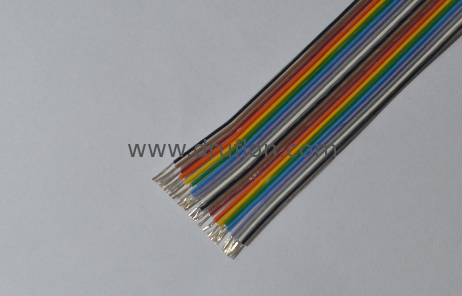ROUND AND FLAT MULTI-CORE CABLES
|
|
ROUND AND FLAT MULTI-CORE CABLES |
APPLICATIONS SPECIFICATIONS SIZE TABLE WHAT IS TWS? ADVANTAGES OF TWS ORDERING INFORMATION
ADVANTAGES APPLICATIONS SPECIAL EQUIPMENT WIRES QUALITY FEATURES CAUTION ADVANTAGES OF TWS LIST OF MIL-W SPEC SHEETS CONDUCTOR SIZE TABLE INSULATED WIRE SIZES COAXIAL CABLES PER MIL-C-17 TABLE OF COAXIAL CABLES MULTI-CORE CABLES HIGH VOLTAGE WIRES & CABLES HVCR SELECTION GUIDELINES HVCR QUALITY ASSURANCE HVCR SIZE TABLE HEATING WIRES WIRES FOR FLOOR HEATING
QUESTIONNAIRE FOR HVCR
PROPERTIES OF PTFE |
 PTFE insulated
multi-core
cables are required mainly for high-reliability and high-temperature
interconnections
for signal and controlapplications. We refer to a
case
where we manufactured a special cable for British Nuclear Energy to
control
a Nuclear Robotic Arm. This cable had 28 members, some for
sensing
temperature, some for audio signals, some for video signals, a few for
operating
the lights inside the reactor, a number of others for activating the
motor,
and so on. Even though most common cables would not have such a
large
number of applications in a single construction, it is sufficient to
illustrate
the varied uses of multi-core cables. PTFE insulated
multi-core
cables are required mainly for high-reliability and high-temperature
interconnections
for signal and controlapplications. We refer to a
case
where we manufactured a special cable for British Nuclear Energy to
control
a Nuclear Robotic Arm. This cable had 28 members, some for
sensing
temperature, some for audio signals, some for video signals, a few for
operating
the lights inside the reactor, a number of others for activating the
motor,
and so on. Even though most common cables would not have such a
large
number of applications in a single construction, it is sufficient to
illustrate
the varied uses of multi-core cables.
A simple twisted pair is a basic example of multi-core cable for signal applications; this is commonly used in communications because of the well-known property ofcommon-mode cancellation. This is an example of balanced transmission as opposed to unbalanced transmission using RF Coaxial cables (click here for details). Unshielded Twisted Pairs (UTP) are now commonly used for LAN cabling (Category 5, 5e, 6 cables). We are presently working on LAN cables for high frequency requirements (such as 400 MHz and above).
SPECIFICATIONS: There are no commonly accepted standards governing multi-core cables; the cores normally refer to MIL standards such as MIL-W-16878, if these are equipment wires, or MIL-C-17 if the cores are RF coaxial cables, and so on. For aircraft applications, MIL-C-27500 is a comphrehensive multi-core spec based on the cores governed by MIL-W-22759. MINIATURE SHIELDED WIRES/PAIRS/MULTI-CORE CABLES In many equipments, circuit frequencies range between 100 KHz and several MHz. In these sensitive high impedance circuits, it is necessary to use shielded wires, and in balanced circuits, shielded twisted pairs (STP)(often with jackets). In these circuits, it is important to prevent interference from external vibration, noise and common mode signals. Problems like mismatch, attenuation and radiation are not significant. Coaxial cables for such applications are expensive and unnecessary. Miniature wires, planetary twisted pairs and multi-core cables utilize fine core conductors in sizes down to AWG 36 (with single or 7 strands). A reliable multi-layer, sintered PTFE insulation of 0.15 mm for single core and 0.18 mm for twisted pairs is then applied. Single, Twisted pair multi-core constructions with or without colour codes, are then shielded and jacketed. The combined radial thickness for shield and jacket is 0.15 mm. PTFE jackets of 0.1 mm wall are preferred to provide shield isolation or selective grounding. SPECIAL SHIELDING TECHNIQUES Temperature or grounding specifications may exclude Aluminised Mylar shields (which are low-cost and light in weight). In such cases, any combination from the following 3 groups can be selected for shielding:
a) Braids or Helically wrapped (served) shieldsThe minimum sizes are: a) SPC AWG 42 (0.06 mm)  Apart from round
multi-core
cables, FLAT Bonded/ Woven Ribbon cables are also available with plain cores, or with twisted
pairs,
or with shielded wires/coaxial cables as cores. In many
situations,
flat cables provide neat solutions for interconnections. When the
space
is limited, the flat cable can be set against the wall and take much
less
space than a round multi-core cable with same numbe of cores.
Also,
where a repeat movement back and forth is desired (for example a drawer
or
door, opening and closing, or a printer head etc), flat cables are
quite
useful. In some applications, the spacing between adjacent cores
of
flat cables can play an important role, say for deciding the
capacitance.
An example is the TV antenna cable. Apart from round
multi-core
cables, FLAT Bonded/ Woven Ribbon cables are also available with plain cores, or with twisted
pairs,
or with shielded wires/coaxial cables as cores. In many
situations,
flat cables provide neat solutions for interconnections. When the
space
is limited, the flat cable can be set against the wall and take much
less
space than a round multi-core cable with same numbe of cores.
Also,
where a repeat movement back and forth is desired (for example a drawer
or
door, opening and closing, or a printer head etc), flat cables are
quite
useful. In some applications, the spacing between adjacent cores
of
flat cables can play an important role, say for deciding the
capacitance.
An example is the TV antenna cable.For Free Design Service, Contact: mukul@druflon.com; druflon@gmail.com; nkrishna@druflon.com Teflon ® is a DuPont Trade Mark | ||||||